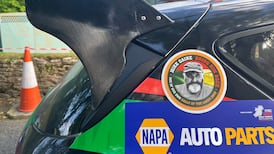The Dalai Lama is first in a series of high-profile visits to Ireland. Let us salute courage, not fame
‘NO MORE heroes anymore,” The Stranglers growled in 1977. Aside from committing possibly the worst rhyme in musical history in the lines, “Whatever happened to all the heroes?/All the Shakespearos?”, The Stranglers choice of heroes was pretty eclectic.
They bemoaned Trotsky getting an ice pick in his ear, but also mourned Lenny, which apparently was not a reference to Lenin but Lenny Bruce, the American comedian. Sancho Panza also gets mention.
Whatever their choice, The Stranglers were ahead of their time in recognising that being a hero is no longer simple.
Today, it is much easier to be a celebrity than a hero, because celebrity allows for spectacular failure whereas heroism demands self-sacrifice and courage. Charlie Sheen is a celebrity whose train-wreck lifestyle holds a kind of gruesome fascination, but unless he manages to face and overcome his demons, he will never be a hero.
Of course, some heroes are celebrities, but not by design. Celebrity is sometimes a byproduct of a heroic action, as in the case of Capt Chesley Sullenberger (Sully), who successfully ditched a US Airways plane in the Hudson river in New York. He said later he had been making small deposits for 42 years in a bank of education and training, which enabled him make a big withdrawal when needed.
Hero-worship is a nod to the origins of the word “hero”, which comes from the ancient Greek idea of a demi-god, someone of stoicism and courage. Sadly, hero-worship is as likely to be applied to someone who is a celebrity as someone who is a hero. Believers everywhere, testify!
Which category do our current crop of famous visitors to Ireland fit? Many people would consider the Dalai Lama to be a hero for his work on inter-religious dialogue, his unstinting advocacy for the environment, and his resistance to oppression in Tibet.
Because of his twinkly and compassionate presence, he bowls over the cynical who normally have nothing to do with the supernatural whatsoever. Funny how people who would scorn the concept of a virgin birth can accommodate the Dalai Lama who, according to believers, is the 14th incarnation of a Tibetan lama who was born in 1361.
The current Dalai Lama began his monastic training at the age of six. Had Pope Benedict XVI begun his training at that age, it would be yet another reason for outrage and demands that the Catholic Church be abolished. Teasing aside, the Dalai Lama radiates a kindness and calm that is utterly captivating. He spoke of hope and forgiveness during his visit this week, qualities we are in dire need of at the moment.
Funny how we will accept that message from a Buddhist, and yet snarl at anyone Irish who suggests it. Buddhism, carefully shorn of its extensive mythology and symbolism, is taking over the western world and even atheists can’t resist its charms.
Sam Harris who, along with Richard Dawkins and Christopher Hitchens, spends most of his time condemning believers, is suspect among other atheists because he believes the Buddhist approach to life has value on a spiritual and ethical level. However, this approach is only acceptable to him if he can ditch the bits of Buddhism that make him itch, such as all religious associations. He, and a lot of others including scientists, want to study the brains of Buddhist meditators. The Dalai Lama has sponsored conferences on neuroscience, and encouraged senior monks to allow their brains to be scanned.
For all the embarrassing religious associations, the brains of these Buddhist meditators are different, apparently showing more emotional balance and positive emotion. That’s partly why the concept of mindfulness is being used in mainstream treatments for depression.
Contemplative Catholic nuns have a similar profile, apparently, but I can’t see recitation of the rosary being prescribed soon.
But even heroes have heroes, and the Dalai Lama says one of his is Richard Moore, the founder of Children in Crossfire. Moore lives forgiveness and hope. Blinded by a rubber bullet, he found, forgave and befriended the soldier responsible, Charles Innes.
That spirit of forgiveness will be notably absent from Sinn Féin and other protesters at the Queen’s visit. Ah, the Queen. Hero or celebrity? Being married to Prince Philip probably qualifies her for hero status.
For most people in Ireland, far from being an embodiment of the old enemy, she is probably merely a mildly interesting celebrity. Yet the symbolic nature of her visit should not be underestimated. Even though we struggle to define precisely who we are, it is to be welcomed that we no longer define ourselves by who we are not, that is, the Brits.
For the Queen to lay a wreath in the Garden of Remembrance or visit Croke Park, the site of Bloody Sunday in 1920, is historic indeed. As the Dalai Lama pointed out, we do not have to forget in order to forgive.
Her visit will be followed by President Barack Obama’s, who definitely has hero status. With the exception of Ronald Reagan and George W Bush, we Irish always manage to love the American president more than swathes of his own people do.
President Obama has returned to form with the “vision thing”. His speech on the kind of America he wishes to build, and the danger of the Republicans undermining the social contract, was masterful. And yet, his visit will probably resemble that of a rock star. Proof, if we needed any, that today the lines between hero and celebrity are blurred indeed.







